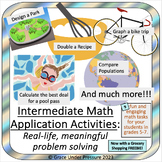Wave Pool Patterns, Expressions, Graphing: Real-Life Pre-Algebra Problem Gr 5-7
- PDF
- Easel Activity
Also included in
- Do you need some new, engaging, and applicable math activities for your 6th Grade math unit on Expressions and Equations? Here are 7 ready-to-print math products that will get your students thinking about how the math they learn in class (exponents, expressions, equivalent expressions, equations, inPrice $14.00Original Price $20.00Save $6.00
- Do you need some new, fun, and engaging lessons for your sixth grade math class? If you want to add a little spice to your grade 6 math program, this is the full-year supplemental resource for you!This 140-page MEGA BUNDLE is chock full of real-life applications, financial literacy lessons, math staPrice $52.00Original Price $79.25Save $27.25
- These eight math application activities and projects are fun additions to an intermediate or middle school math program. They involve real-life applications of the skills your grade 5-7 students are learning in class. Each activity is totally ready-to-go with clear instructions, engaging printables,Price $15.50Original Price $23.50Save $8.00
Description
Here is a ready-to-print real world math activity for a pre-algebra unit in grades 5-7 including expressions, tables of values, and graphing.
• This activity lets students explore pattern rules, expressions, and line graphs using a real-life scenario that is of interest to them: getting the best deal on a pass to a local wave pool.
• Read through the activity as a class after you have been working on a patterning or pre-algebra unit.
• This can be used as an in-class assignment, weekly homework task, or summative assessment.
• It can be easily marked out of 20 points using the provided answer key.
First, students complete two tables of values based on the two ways to pay to go to the wave pool.
Next, they write a pattern rule in words and an expression with a variable to describe one of the scenarios.
Then they create a line graph with all of the necessary features (titles, scale, data points) to compare the two ways to pay. They should notice there is a point where the two lines cross. This will be important for their decision making.
Finally, students will have to write about their mathematical ideas and clearly explain their decision making process in words. Which payment option would they choose and why?
There is also a bonus question/extension for early finishers.
What's Included: 7 Page PDF Ready to Print and Use!
Title Page and Teacher Instructions
3 Page Student Worksheet
3 Page Complete Answer Key









